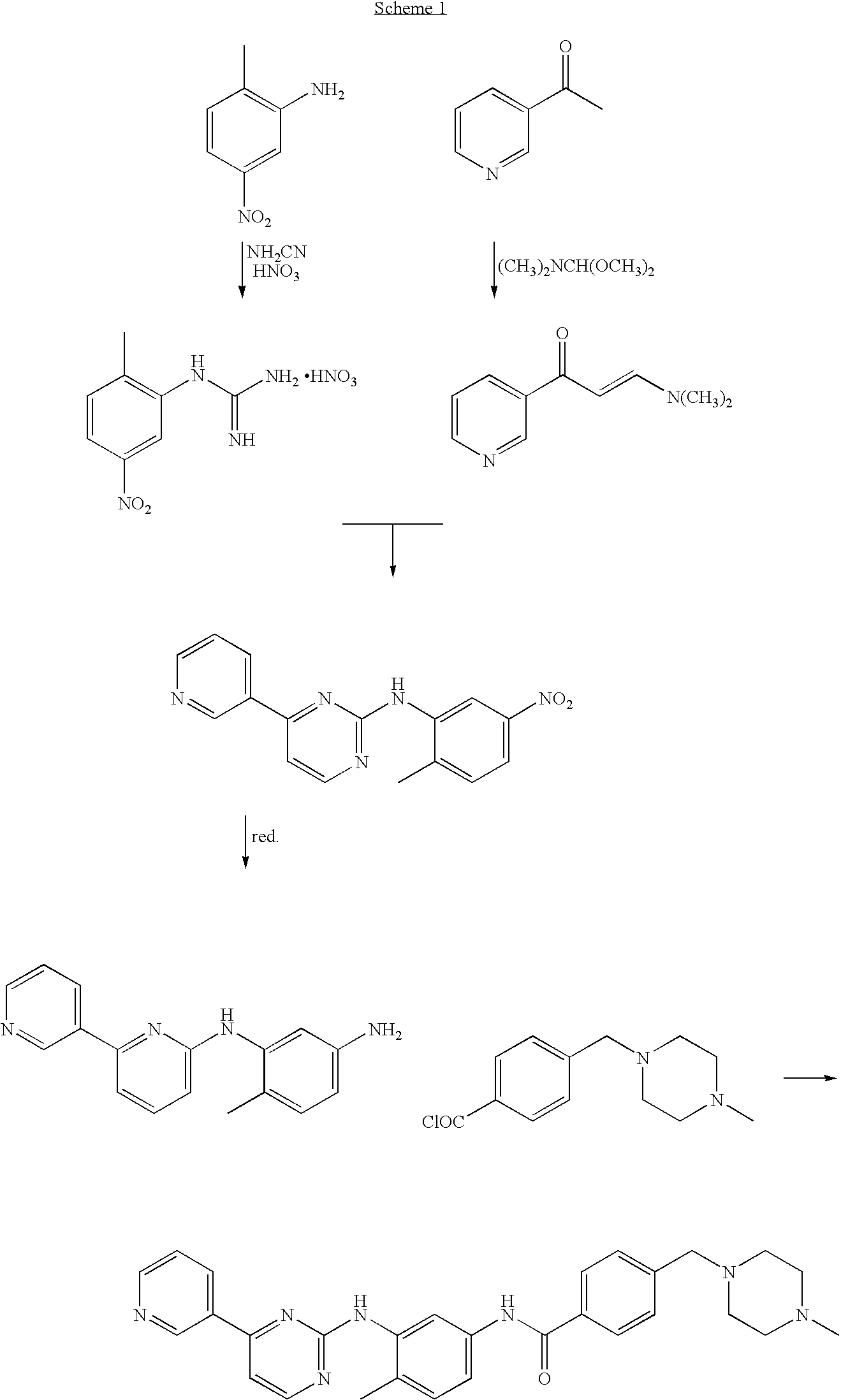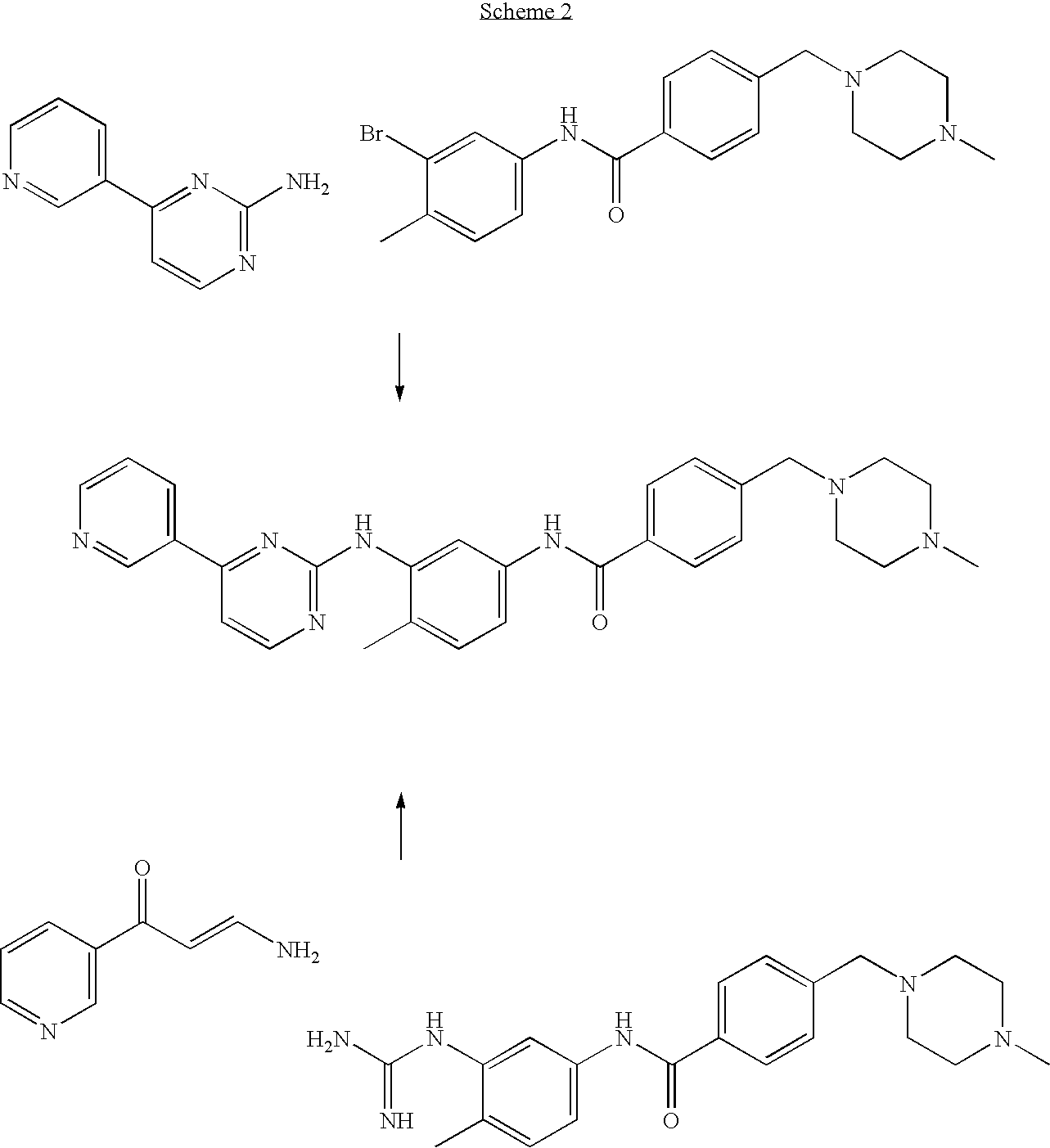Process for preparation of imatinib base
a technology of imatinib and base, which is applied in the field of process for the preparation of imatinib base, can solve the problems of poor yield of 3-(dimethylamino), troublesome synthesis and difficult scaling up, and poor yield of product isolated by recrystallization (50-66%) compared to solid crude product,
- Summary
- Abstract
- Description
- Claims
- Application Information
AI Technical Summary
Benefits of technology
Problems solved by technology
Method used
Image
Examples
example 1
[0105]20 g of 2-Methyl-5-nitroaniline (0.131 mol; 1 eq.), 11.05 g of cyanamide (0.263 mol; 2 eq.) and 80 mL of isopropyl alcohol were placed in a reactor flask. The reaction mixture was heated to 80° C., and 18 mL of concentrated hydrochloric acid was slowly added dropwise within 80 minutes. The reaction mixture was stirred for 1 hour while maintaining the temperature at 80° C. Next, 6 mL of concentrated hydrochloric acid was added dropwise and the reaction mixture was kept at 80° C. for 2 hours. The reaction mixture was cooled down to 60° C. and 10 mL of 65% nitric acid (0.142 mol, 1.08 eq.) was added dropwise and the mixture was left with stirring until it was cooled down to room temperature. The solid product was filtered off, washed with 50 mL of isopropyl alcohol and dried in the air to afford 27.45 g (yield 81.1%) of 1-(2-methyl-5-nitrophenyl)guanidine nitrate, m.p. 203-206° C.; 1H NMR (DMSO-d6, 200 MHz): 2.32 (3H, s, CH3), 7.44 (4H, m, 4×NH), 7.64 (1H, d, J=8.2 Hz, 3-H), 8.09...
example 2
[0106]26.60 g of 3-acetylpyridine (0.219 mol; 1 eq.) and 44.0 mL of N,N-dimethylformamide dimethyl acetal (39.47 g; 0.331 mol; 1.508 eq.) were placed in a reactor flask and the mixture was refluxed for 1.5 h. Methanol, produced in the reaction was removed by distillation and the mixture was refluxed for further 2 hours. The rest of methanol and excess of the acetal were removed by distillation under slightly reduced pressure. The hot residue was treated with 100 mL DMF, and, after cooling down, with 56.3 g of 1-(2-methyl-5-nitrophenyl)guanidine nitrate (0.219 mol; 1 eq.). A solution of 8.8 g of sodium hydroxide in 17 mL of water was then added dropwise and the mixture was refluxed for 8 hours in an oil bath. Water (200 mL) was added with care to the hot solution, and the contents of the flask were poured to 700 mL of warm water. The whole mixture was cooled with stirring to room temperature. The precipitated solid was isolated by filtration and dried in the air to afford 49.41 g of ...
example 3
[0107]To a stirring suspension of N-(5-nitro-2-methylphenyl)-4-(3-pyridinyl)-2-pyrimidineamine (65 g; 0.21 mol) in methanol (1400 mL) was added wet Raney's nickel (6.25 g) followed by the first portion of an 80% solution of hydrazine hydrate (52.5 g; 0.84 mol) in methanol (50 mL). After 1 hour, the reaction mixture was cooled down to 35° C. and stirring was continued for further 1.5 hour. Next, the second portion of an 80% solution of hydrazine hydrate (52.5 g; 0.84 mol) in methanol (50 mL) was added dropwise and stirring was continued for 3 hours. The reaction mixture was cooled down to room temperature and filtered through a pad of Celite. The layer of Celite was washed with methanol (150 mL). The combined filtrates were concentrated in vacuo, treated with dichloromethane (500 mL), and the organic layer was washed with water (3×300 mL). The organic layer was dried with anhydrous MgSO4 (12 g) and filtered through a pad of SiO2 (60 g). The layer of silica gel was washed subsequently...
PUM
| Property | Measurement | Unit |
|---|---|---|
| temperature | aaaaa | aaaaa |
| temperature | aaaaa | aaaaa |
| temperature | aaaaa | aaaaa |
Abstract
Description
Claims
Application Information
 Login to View More
Login to View More - R&D
- Intellectual Property
- Life Sciences
- Materials
- Tech Scout
- Unparalleled Data Quality
- Higher Quality Content
- 60% Fewer Hallucinations
Browse by: Latest US Patents, China's latest patents, Technical Efficacy Thesaurus, Application Domain, Technology Topic, Popular Technical Reports.
© 2025 PatSnap. All rights reserved.Legal|Privacy policy|Modern Slavery Act Transparency Statement|Sitemap|About US| Contact US: help@patsnap.com



